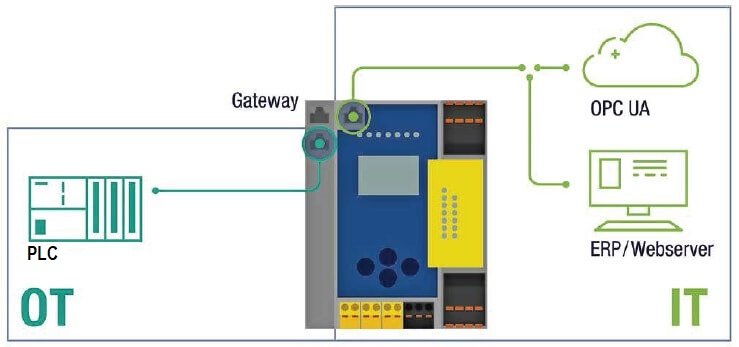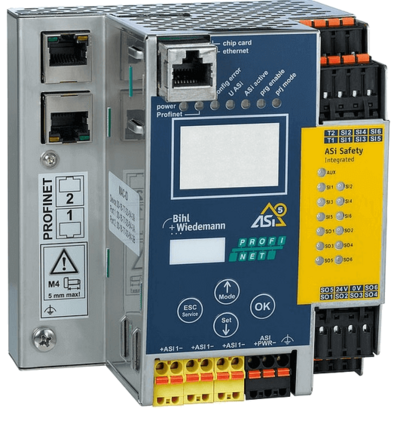Industry 4.0
Bihl+Wiedemann provides optimal conditions for implementing Industry 4.0 at field level. For a successful implementation of Industry 4.0 projects, it must be ensured that systems, machines and assembly lines communicate permanently with each other. This communication generates huge amounts of data at sensor level. A powerful data shuttle is needed to evaluate them.
That is where Bihl+Wiedemann ASi-5 finds its use: the latest generation of the standardized AS-Interface fieldbus system offers a high data bandwidth and short cycle times. It makes it easy to integrate intelligent sensors such as IO-Link, which are so important for Industry 4.0 and smart factories. Bihl+Wiedemann ASi-5 gateways transmit the sensor data to the IT via OPC UA. There they become valuable information, without which Industry 4.0 projects or predictive maintenance would not be implementable.

As an “edge device”, the ASi Gateway forms the interface between IT and OT. The connection to a control system (Operational Technology) is made via the fieldbus interface. Diagnostic data and other IT-relevant data are transmitted in parallel via the diagnostic interface by means of OPC UA.
Industry 4.0 stands for the digital revolution that is fundamentally changing all industrial sectors. Of course, even the enormous increase in computer performance and improved networking have a massive impact on automation. In this context, Industry 4.0 can be reduced to the following core: it is becoming increasingly easier and cheaper to capture data on a large scale in industrial processes. And the skillful analysis of such data creates real added value. Because in a smart factory with distributed systems, intelligent sensors and actuators are becoming increasingly important – not least because of their continuously increasing number.
Efficient networks are indispensable
TomTom can be taken as a good example of value-added data evaluation. Years ago, the navigation system manufacturer, together with Vodafone, had already anonymously evaluated how mobile phones switched from one radio cell to the next. This enabled the measurement of traffic speed on highway sections – without having to install sensors or software on the cellphones. Today Google can usually tell the location of any cellphone. But the example of TomTom is a particularly good illustration of how new functions are created through the intelligent analysis of data.
However, to be able to use the data, you need high-performance networks with sufficient bandwidth – especially sensors that measure switching signals and additional information, such as temperature values. The networks must also be sufficiently fast to be able to evaluate time measurements. In terms of the TomTom example, it means that: meaningful speeds can only be derived from the position data if the sampling rate is sufficiently high. Bihl+Wiedemann ASi-5 devices offer the bandwidth required for Industry 4.0 and are also fast enough.
High data bandwidth with Bihl+Wiedemann ASi-5 devices
ASi-5 – the latest generation of the standardized AS-Interface fieldbus system – boasts high data bandwidth and short cycle times. The evolution of ASi can be compared with the bandwidth increase of the Internet.
For example, new Bihl+Wiedemann ASi-5 slaves can cyclically transmit up to 32 bytes of I/O data per participant: in 1.27 ms, ASi transmits a total of up to 8 bytes per participant. The advantage is that besides the cyclic data, even other data such as parameters and diagnostics can be transported. The data bandwidth of ASi-5 is therefore sufficient even for demanding applications.
Bihl+Wiedemann ASi devices also provide valuable data as intended in Industry 4.0. The interesting data comes from the connected sensors, but they are connected to the Bihl+Wiedemann gateways via ASi.
The gateways also provide additional diagnostic data. Thanks to them, any faults, such as a cut cable, can be quickly found and rectified.
ASi Gateways relieve control system load
gateways are typically connected to a control system through their fieldbus interface. In IoT jargon, they thus belong to operational technology (OT). On the other hand, the data collection and evaluation is assigned to the IT and must not burden or disrupt the OT.
The diagnostic interface of the Bihl+Wiedemann gateways is therefore ideal. This is because it can be assigned to the IT and provides valuable diagnostic data while the OT manages the fieldbus interface. As an interface between IT and OT, the gateways are so-called “edge devices”. By linking IT and OT, data structures can be created for Industry 4.0 or for the industrial Internet. ASi simplifies the data transfer “from the bottom up”. In the system hierarchy, the bridge from the field level to the operations control level becomes wider and faster in terms of cycle time.
Bihl+Wiedemann ASi-5 gateways are also the most decentralized participant or the first participant in the automation pyramid that can communicate via Internet protocols. In this way, they relieve the control system of irrelevant things.

Bihl+Wiedemann ASi-5/ASi-3 gateways are the first participant in the automation pyramid to be able to communicate via Internet protocols. They are available in different versions.
ASi-5 integrates intelligent IO-Link sensors
The data of the connected sensors can already be retrieved and collected via OPC UA – completely independent of the operational technology. Nowadays, most intelligent sensors have an IO-Link interface. This is very well suited for Industry 4.0 projects, but cannot be integrated into IT networks due to the lack of TCP/IP. Such sensors can now be easily integrated via ASi-5. Furthermore, their data can be transferred to the IT via the gateway and OPC UA. OPC UA in Bihl+Wiedemann gateways gives access to a wide range of machine data. For example, device diagnostics, fieldbus bits or addressing of slaves can be easily accessed via the company network.

Intelligent IO-Link devices with up to 32 bytes can be integrated easily and economically via ASi-5. Bihl+Wiedemann ASi-5/ASi-3 gateways transport the data to where it is needed.
Bihl+Wiedemann meets increasing security requirements
Since Industry 4.0 devices rely heavily on networking, the topic of data security is gaining enormous significance. After all, any device with access to other devices in a network can be used as an attack platform. It thus becomes a vector for attacks on other devices. For this reason, the security requirements for networked industrial devices are increasing very rapidly.
Due to the long service life of industrial equipment, one thing is certain: weak points in the device software must be found and rectified long after the devices have been sold.
In order to ensure data security, Bihl+Wiedemann offers authenticated encryption methods such as AES-256 with up to SHA-512 or RSA. Customer-specific certificates for TLS and OPC UA communication are also supported. This allows the devices to be seamlessly integrated into existing IT security concepts. Furthermore, Bihl+Wiedemann offers the possibility of using signed software updates, which are authenticated by the device before use. Software updates and OPC UA can also be locked locally on the device – a reliable and absolute protection.
GE Digital Achilles® Robustness Test (Level 1 and 2, Version No.
Ethernet fieldbus interface (PROFINET, EtherNet/IP) and Ethernet diagnostic interface of the ASi-5/ASi-3 gateways are submitted to strict robustness testing via the Achilles Test Software to ensure robustness against vulnerabilities to cyber attacks. The field update capabilities of the gateway enable continuous firmware and security updates to continuously improve the functionality and robustness of the device.
Data becomes valuable information
Collect large volumes of data simply, inexpensively and efficiently, and transport it directly to where it can be used – in whatever form: ASi-5 and the current gateway generation of Bihl+Wiedemann offer ideal conditions to turn the volumes of available data into valuable information as intended in Industry 4.0.
